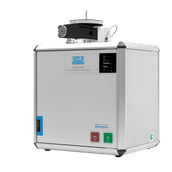Paper electrified by copper particles
The polymer chemistry Research Group at the University of Helsinki, Finland, has succeeded in producing nano-sized metallic copper particles. When the size of particles is reduced to a nano-scale, the properties of the material undergo substantial changes. Unlike in bulk materials, in nanoparticles the number of surface atoms is considerably greater than the number of atoms inside the material, which, among other things, makes the melting temperature of nanomaterials very low. With suitable heat treatment (sintering), the particles manufactured by the research group can be made to form electricity-conducting layers and patterns on paper.
The research result is interesting in that polymer-protected metal particles can also be used in various electronics applications: various kinds of intelligent patterns can be printed on paper that, in the future, may replace components such as electronics boards.
The purpose of the research was to test the ability of polymeric and small-molecule compounds that contain amine groups to protect copper nanoparticles during their manufacturing stage. The particles were manufactured with either poly(ethylene imine) (PEI) or tetraethylenepentamine (TEPA) used as protecting compounds. The average size of the particles at room temperature was 8.5 nm (with PEI as the protecting agent) or 19.4 nm (with TEPA as the protecting agent). Slightly oxidised at their surface, the particles were sintered to the paper surface, and the electrical conductivity of the layer thus formed was measured. Particles manufactured using PEI released the protective agent during sintering at relatively low temperatures (150-200 °C). At these temperatures, the size of the particles increased rapidly. The electrical conductivity of the sintered particles was good, which makes them promising materials for use in electronics printed on paper.
At the University of Helsinki, a research group led by Professor Heikki Tenhu synthesises the so-called intelligent polymers and studies controlled polymerisation reactions. Polymers are large-molecule compounds that, as functional materials, change their properties according to the changing ambient conditions.
Original article: Petri Pulkkinen et al.; "Poly(ethylene imine) and Tetraethylenepentamine As Protecting Agents for Metallic Copper Nanoparticles"; ACS Appl. Mater. Interfaces 1(2) 519-525, 2009
Most read news
Topics
Organizations
These products might interest you

CHSN-O, CN and N Elemental Analyzers by Velp Scientifica
State-of-the-art Elemental Analyzers for N, CN and CHSN-O in organic samples
Consistency, ease of use, and premium features for elemental analysis following official standards

HYPERION II by Bruker
FT-IR and IR laser imaging (QCL) microscope for research and development
Analyze macroscopic samples with microscopic resolution (5 µm) in seconds

Get the analytics and lab tech industry in your inbox
By submitting this form you agree that LUMITOS AG will send you the newsletter(s) selected above by email. Your data will not be passed on to third parties. Your data will be stored and processed in accordance with our data protection regulations. LUMITOS may contact you by email for the purpose of advertising or market and opinion surveys. You can revoke your consent at any time without giving reasons to LUMITOS AG, Ernst-Augustin-Str. 2, 12489 Berlin, Germany or by e-mail at revoke@lumitos.com with effect for the future. In addition, each email contains a link to unsubscribe from the corresponding newsletter.























































